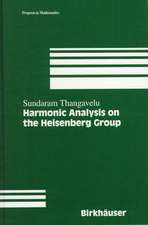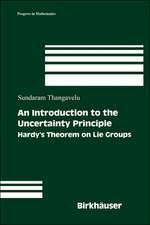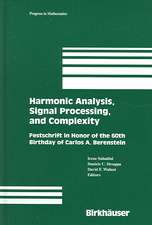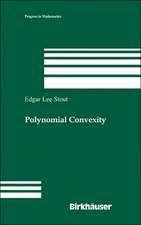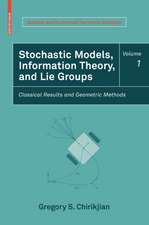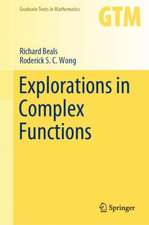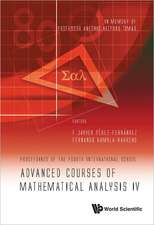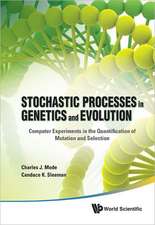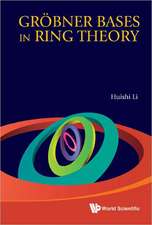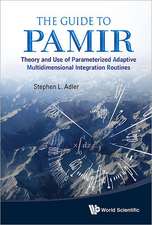Handbook of Complex Variables
Autor Steven G. Krantzen Limba Engleză Hardback – 14 oct 1999
| Toate formatele și edițiile | Preț | Express |
|---|---|---|
| Paperback (1) | 641.53 lei 6-8 săpt. | |
| Birkhäuser Boston – 10 oct 2012 | 641.53 lei 6-8 săpt. | |
| Hardback (1) | 645.79 lei 6-8 săpt. | |
| Birkhäuser Boston – 14 oct 1999 | 645.79 lei 6-8 săpt. |
Preț: 645.79 lei
Preț vechi: 759.76 lei
-15% Nou
Puncte Express: 969
Preț estimativ în valută:
123.57€ • 129.02$ • 102.27£
123.57€ • 129.02$ • 102.27£
Carte tipărită la comandă
Livrare economică 04-18 aprilie
Preluare comenzi: 021 569.72.76
Specificații
ISBN-13: 9780817640118
ISBN-10: 0817640118
Pagini: 290
Ilustrații: XXIV, 290 p.
Dimensiuni: 155 x 235 x 21 mm
Greutate: 0.57 kg
Ediția:1999
Editura: Birkhäuser Boston
Colecția Birkhäuser
Locul publicării:Boston, MA, United States
ISBN-10: 0817640118
Pagini: 290
Ilustrații: XXIV, 290 p.
Dimensiuni: 155 x 235 x 21 mm
Greutate: 0.57 kg
Ediția:1999
Editura: Birkhäuser Boston
Colecția Birkhäuser
Locul publicării:Boston, MA, United States
Public țintă
ResearchCuprins
1 The Complex Plane.- 1.1 Complex Arithmetic.- 1.2 The Exponential and Applications.- 1.3 Holomorphic Functions.- 1.4 The Relationship of Holomorphic and Harmonic Functions.- 2 Complex Line Integrals.- 2.1 Real and Complex Line Integrals.- 2.2 Complex Differentiability and Conformality.- 2.3 The Cauchy Integral Theorem and Formula.- 2.4 A Coda on the Limitations of the Cauchy Integral Formula.- 3 Applications of the Cauchy Theory.- 3.1 The Derivatives of a Holomorphic Function.- 3.2 The Zeros of a Holomorphic Function.- 4 Isolated Singularities and Laurent Series.- 4.1 The Behavior of a Holomorphic Function near an Isolated Singularity.- 4.2 Expansion around Singular Points.- 4.3 Examples of Laurent Expansions.- 4.4 The Calculus of Residues.- 4.5 Applications to the Calculation of Definite Integrals and Sums.- 4.6 Meromorphic Functions and Singularities at Infinity.- 5 The Argument Principle.- 5.1 Counting Zeros and Poles.- 5.2 The Local Geometry of Holomorphic Functions.- 5.3 Further Results on the Zeros of Holomorphic Functions.- 5.4 The Maximum Principle.- 5.5 The Schwarz Lemma.- 6 The Geometric Theory of Holomorphic Functions.- 6.1 The Idea of a Conformal Mapping.- 6.2 Conformal Mappings of the Unit Disc.- 6.3 Linear Fractional Transformations.- 6.4 The Riemann Mapping Theorem.- 6.5 Conformal Mappings of Annuli.- 7 Harmonic Functions.- 7.1 Basic Properties of Harmonic Functions.- 7.2 The Maximum Principle and the Mean Value Property.- 7.3 The Poisson Integral Formula.- 7.4 Regularity of Harmonic Functions.- 7.5 The Schwarz Reflection Principle.- 7.6 Harnack’s Principle.- 7.7 The Dirichlet Problem and Subharmonic Functions.- 7.8 The General Solution of the Dirichlet Problem.- 8 Infinite Series and Products.- 8.1 Basic Concepts Concerning Infinite Sums andProducts.- 8.2 The Weierstrass Factorization Theorem.- 8.3 The Theorems of Weierstrass and Mittag-Leffler.- 8.4 Normal Families.- 9 Applications of Infinite Sums and Products.- 9.1 Jensen’s Formula and an Introduction to Blaschke Products.- 9.2 The Hadamard Gap Theorem.- 9.3 Entire Functions of Finite Order.- 10 Analytic Continuation.- 10.1 Definition of an Analytic Function Element.- 10.2 Analytic Continuation along a Curve.- 10.3 The Monodromy Theorem.- 10.4 The Idea of a Riemann Surface.- 10.5 Picard’s Theorems.- 11 Rational Approximation Theory.- 11.1 Runge’s Theorem.- 11.2 Mergelyan’s Theorem.- 12 Special Classes of Holomorphic Functions.- 12.1 Schlicht Functions and the Bieberbach Conjecture.- 12.2 Extension to the Boundary of Conformal Mappings.- 12.3 Hardy Spaces.- 13 Special Functions.- 13.0 Introduction.- 13.1 The Gamma and Beta Functions.- 13.2 Riemann’s Zeta Function.- 13.3 Some Counting Functions and a Few Technical Lemmas.- 14 Applications that Depend on Conformal Mapping.- 14.1 Conformal Mapping.- 14.2 Application of Conformal Mapping to the Dirichlet Problem.- 14.3 Physical Examples Solved by Means of Conformal Mapping.- 14.4 Numerical Techniques of Conformal Mapping.- Appendix to Chapter 14: A Pictorial Catalog of Conformal Maps.- 15 Transform Theory.- 15.0 Introductory Remarks.- 15.1 Fourier Series.- 15.2 The Fourier Transform.- 15.3 The Laplace Transform.- 15.4 The z-Transform.- 16 Computer Packages for Studying Complex Variables.- 16.0 Introductory Remarks.- 16.1 The Software Packages.- Glossary of Terms from Complex Variable Theory and Analysis.- List of Notation.- Table of Laplace Transforms.- A Guide to the Literature.- References.
Recenzii
"This modern book can be warmly recommended to mathematicians as well as to users of applied texts in complex analysis; in particular it will be useful to students preparing for an examination in the subject." —Mathematical Reviews
"Creating a 'handbook' such as this is an interesting concept, and to this reviewer’s knowledge this is the only one of its type in complex analysis. . . . This book may well be timely and useful to the readers it is intended for: working scientists, students, and engineers . . . The topics contained are quite broad . . . It is noteworthy that a glossary is included that provides the reader with a useful guide to terminology and basic concepts. Other valuable features are: (1) a discussion of the available computer packages that can do some complex analysis such as Maple and Mathematica, (2) a pictorial catalog of conformal well-known maps, and (3) tables of Laplace transforms." —SIAM Review
"Krantz...has two audiences in mind for this handbook: first, the working scientist, with no background in complex analysis, who seeks a specific result to solve a specific problem; and second, the mathematician or scientist who once studied complex analysis and now seeks a compendium of results as an aid to memory. Though Krantz warns that this handbook contains no theory...and thus cannot serve as a textbook, the undergraduate student of complex analysis will nevertheless find certain sections replete with instructive examples (e.g., applications of contour integrations to definite integrals and sums; conformal mapping). Also, the glossary of terminology and notation should offer a useful aid to study.... Students should also see the chapter devoted to surveying computer packages for the study of complex variables. In an undergraduate library, this book can be counted as a supplement to an otherwise strong collection in functions of a single complexvariable." —Choice
"This handbook of complex variables is a comprehensive references work for scientists, students and engineers who need to know and use the basic concepts in complex analysis of one variable. It is not a book of mathematical theory but a book of mathematical practice. All basic ideas of complex analysis and many typical applications are treated. It is also written in a very vivid style and it contains many helpful figures and graphs." ---Zentralblatt MATH
"Creating a 'handbook' such as this is an interesting concept, and to this reviewer’s knowledge this is the only one of its type in complex analysis. . . . This book may well be timely and useful to the readers it is intended for: working scientists, students, and engineers . . . The topics contained are quite broad . . . It is noteworthy that a glossary is included that provides the reader with a useful guide to terminology and basic concepts. Other valuable features are: (1) a discussion of the available computer packages that can do some complex analysis such as Maple and Mathematica, (2) a pictorial catalog of conformal well-known maps, and (3) tables of Laplace transforms." —SIAM Review
"Krantz...has two audiences in mind for this handbook: first, the working scientist, with no background in complex analysis, who seeks a specific result to solve a specific problem; and second, the mathematician or scientist who once studied complex analysis and now seeks a compendium of results as an aid to memory. Though Krantz warns that this handbook contains no theory...and thus cannot serve as a textbook, the undergraduate student of complex analysis will nevertheless find certain sections replete with instructive examples (e.g., applications of contour integrations to definite integrals and sums; conformal mapping). Also, the glossary of terminology and notation should offer a useful aid to study.... Students should also see the chapter devoted to surveying computer packages for the study of complex variables. In an undergraduate library, this book can be counted as a supplement to an otherwise strong collection in functions of a single complexvariable." —Choice
"This handbook of complex variables is a comprehensive references work for scientists, students and engineers who need to know and use the basic concepts in complex analysis of one variable. It is not a book of mathematical theory but a book of mathematical practice. All basic ideas of complex analysis and many typical applications are treated. It is also written in a very vivid style and it contains many helpful figures and graphs." ---Zentralblatt MATH


